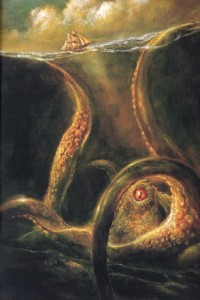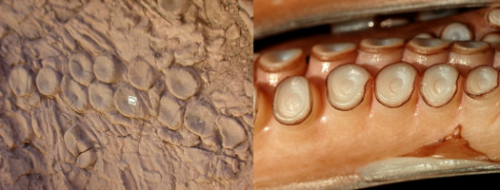 Of all invertebrates, the octopus is considered the most intelligent, and sadly, rather underrated. They’ve been caught on video wrestling sharks to death like sea-dwelling honey badgers, using tools and opening twist-cap bottles. And according to at least one paleontologist, their ancestors may have been bigger, smarter, scarier and perhaps even a bit artistic.
Of all invertebrates, the octopus is considered the most intelligent, and sadly, rather underrated. They’ve been caught on video wrestling sharks to death like sea-dwelling honey badgers, using tools and opening twist-cap bottles. And according to at least one paleontologist, their ancestors may have been bigger, smarter, scarier and perhaps even a bit artistic.The Triassic World
During the Triassic Period, a creature we call Ichthyosaur swam the seas, chowing down on whatever it wanted–it was the size of a school bus and had a mouthful of jagged teeth, and until Monday, paleontologists assumed it sat at the top of its watery food chain. But a stash of nine interestingly arranged, fossilized icthyosaur bodies discovered in Nevada have long confounded researchers, who haven’t been able to determine how they died. Formerly, it was believed the seas were shallow in that location and the giant proto-whales fell victim to an algae bloom. But evidence from the surrounding rocks indicate the seas were still deep at the time of their demise, leaving science with something of a mystery.
That’s where Mount Holyoke College paleontologist Mark McMenamin comes in. “Charles Camp puzzled over these fossils in the 1950s,” said McMenamin. “In his papers he keeps referring to how peculiar this site is. We agree, it is peculiar.” See, the bones of these ichthyosaurs are etched differently from one another, indicating that they didn’t die at the same time. But since they’re all buried together, something interesting had to have happened. And McMenamin thinks that “something” is the work of kraken.
Deliberate Burial
McMenamin believes that the midden-building and predation behaviors observed in modern octopuses–specifically that of the famous Shark vs. Octopus video, wherein an unassuming dog shark gets totally pwned by a seemingly mild-mannered cephalopod–support the theory that gargantuan prehistoric kraken were terrorizing the ichthyosaur population, “either drowning them or breaking their necks.” Suspiciously twisted necks and many broken ribs from the ichthyosaur dig seem to support the idea, as fantastical as it is. But weirdest of all is how the bones came to be buried together, and why their arrangement seems bizarre: “I think that these things were captured by the kraken and taken to the midden and the cephalopod would take them apart,” and rearrange them into what McMenamin believes is “the earliest known self portrait.”
In the fossil bed, some of the shonisaur vertebral disks are arranged in curious linear patterns with almost geometric regularity, McMenamin explained.The proposed Triassic kraken, which could have been the most intelligent invertebrate ever, arranged the vertebral discs in double line patterns, with individual pieces nesting in a fitted fashion as if they were part of a puzzle.To illustrate, the bones are arranged like this:

That’s not even a little bit creepy.
Or is it Pareidolia? Soft-bodied animals, by virtue of definition, have nothing to leave in the fossil layer, so McMenamin’s tentacled beast will likely never turn up even if it did exist. And this presents something of a problem for the theory, since many researchers are “highly skeptical” of his “evidence.” Roger Hanlon, a marine biologist at the Marine Biological laboratory in Woods Hole, Massachusetts, says,”There’s nothing in the scientific literature that suggests that modern-day cephalopods do anything like this.” And according to Dr. Hans-Dieter Sues, curator of vertebrate paleontology at the Smithsonian’s National Museum of Natural History, the Nevada site “essentially represents a mass burial ground for ichthyosaurs in a shallow sea.” Speaking to Christian Science Monitor, Dr. Thomas Holtz Jr. of the University of Maryland declares that McMenamin’s approach to understanding the ichthyosaur peculiarities “is too many steps away from the evidence to call it science.”
But that doesn’t mean that McMenamin is universally scorned: science writers and kraken enthusiasts are rooting for McMenamin and his Triassic tentacled leviathan. Rebecca Boyle of PopSci is sympathetic, hypothesizing that “the hypothetical kraken was just lonely, and, unable to clone itself [as some modern jellyfish can], it made an artistic rendering of an imaginary friend? It seems possible, although maybe less possible [than] the imagined kraken.” But if moral support is what McMenamin needs, Cyriaque Lamar at io9 has got it in spades: ”[T]he possibility of finding that which is essentially a gargantuan mollusk’s macaroni illustration? That’s the kind of glorious crazy you hope is reality.”
What do you think, guys? Is McMenamin’s idea a little too crack-pot to hold water, or is there maybe something to this whole self-expressive kraken thing?
Sources:
- GSA Press Release: Giant Kraken Lair Discovered
- Did an Ancient Kraken Create Its Own Friends? What About a Modern Jellyfish?
- Giant prehistoric krakens may have sculpted self-portraits using ichthyosaur bones
- Kraken monster ruled ancient seas? Scientists wary of new theory.
- Kraken Versus Ichthyosaur: Let the Battle Commence

No comments:
Post a Comment